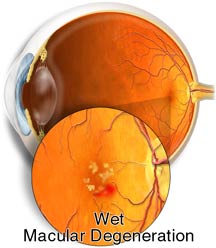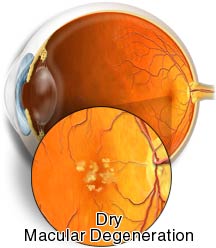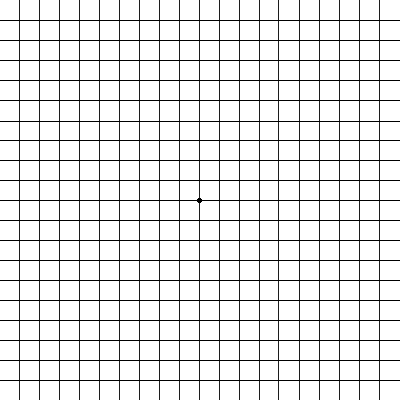Age-related macular degeneration (ARMD) is a degenerative condition of the macula (the central retina). It is one of the most common causes of vision loss in the over 50's, and its prevalence increases with age. AMD is caused by hardening of the arteries that nourish the retina. This deprives the sensitive retinal tissue of oxygen and nutrients that it needs to function and thrive. As a result, the central vision deteriorates.
 |
| This example demonstrates what a patient with advanced macular degeneration sees. |
Macular degeneration varies widely in severity. In the worst cases, it causes a complete loss of central vision, making reading or driving impossible. For others, it may only cause slight distortion. Fortunately, macular degeneration does not cause total blindness since it does not affect the peripheral vision.
What is the difference between wet and dry macular degeneration?
AMD is classified as either wet or dry. About 10% of patients who suffer from macular degeneration have wet AMD. This type occurs when new vessels form to improve the blood supply to oxygen-deprived retinal tissue. However, the new vessels are very delicate and break easily, causing bleeding and damage to surrounding tissue.
 |
 |
|
Patients with wet macular degeneration develop new blood vessels under the retina. This causes haemorrhage, swelling, and scar tissue but it can be treated with laser in some cases. |
Dry maculardegeneration, |
The dry type is much more common and is characterized by drusen and loss of pigment in the retina. Drusen are small, yellowish deposits that form within the layers of the retina.
Macular degeneration may be caused by variety of factors. Genetics, age, nutrition, smoking, and sunlight exposure may all play a role.
Signs and Symptoms
- Loss of central vision. This may be gradual for those with the dry type. Patients with the wet type may experience a sudden decrease of the central vision.
- Difficulty reading or performing tasks that require the ability to see detail
- Distorted vision (Straight lines such as a doorway or the edge of a window may appear wavy or bent.)
Treatment
There is no proven medical therapy for dry macular degeneration. In selected cases of wet macular degeneration, laser photocoagulation is effective for sealing leaking or bleeding vessels. Unfortunately, laser photocoagulation usually does not restore lost vision, but it may prevent further loss. Early diagnosis is critical for successful treatment of wet macular degeneration.Patients can help the eye care practitioner detect early changes by monitoring vision at home with an Amsler grid.
Nutrition and macular degeneration
Several recent studies have indicated a strong link between nutrition and the development of macular degeneration. It has been scientifically demonstrated that people with diets high in fruits and vegetables (especially leafy green vegetables) have a lower incidence of macular degeneration. More studies are needed to determine if nutritional supplements can prevent progression in patients with existing disease.
Tips for AMD patients
If you've been diagnosed with AMD, making a few simple lifestyle changes could have a positive impact on the health of your retina.
- Monitor your vision daily with an Amsler grid. By checking your vision regularly, changes that may require treatment can be detected early.
- Take a multi-vitamin with zinc. (check with your eye care practitioner for a recommendation). Antioxidants, along with zinc andlutein are essential nutrients, all found in the retina. It is believed that people with AMD may be deficient in these nutrients.
- Incorporate dark leafy green vegetables into your diet. These include spinach, collard greens, kale and turnip greens.
- Always protect your eyes with sunglasses that have UV protection. Ultraviolet rays are believed to cause damage to the pigment cells in the retina.
- Quit smoking. Smoking impairs the body's circulation, decreasing the efficiency of the retinal blood vessels.
- Exercise regularly. Cardiovascular exercise improves the body's overall health and increases the efficiency of the circulatory system.
These are a few tips to make reading easier:
-
Use a halogen light. These have less glare and disperse the light better than standard light bulbs.
-
Shine the light directly on your reading material. This improves the contrast and makes the print easier to see.
-
Use a hand-held magnifier. A magnifier can increase the print size dramatically.
-
Try large-print or audio books. Most libraries and bookstores have special sections reserved for these books.
-
Consult a low vision specialist. These professionals are specially trained to help visually impaired patients improve their quality of life. After a personalized consultation, they can recommend appropriate magnifiers, reading aids, practical tips, and many resources.
Amsler Grid

- Use a bright reading light
- Wear your reading glasses if appropriate
- Hold the chart approximately 14-16 inches from your eye
- Cover one eye
- Look at center dot
- Note irregularities (wavy, size, gray, fuzzy)
- Repeat the test with your other eye
- Contact your eye care practitioner if you see any irregularities or notice any changes
Illustrations by Mark Erickson
With acknowledgement to St. Lukes Eye Hospital.
